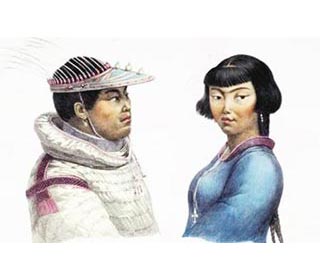The Native Indians of Alaska was divided into several groups. The Tlingit, Haida an Tsimshian (coastal Indians) consisted of several Indian tribes and are also known as First Nations. The Aleut lived in the Aleutian Islands off the coast of mainland Alaska. The native Athabascan Indians inhabited the interior of the state. There were two groups of Eskimos, the Inupiat (Northern Eskimos) and the Yupik (Southern Eskimos). Fast Facts about the History of Alaska Indians
The climate, land, history, environment and natural resources that were available to the indigenous Indian tribes in Alaska resulted in the adoption of the Arctic Culture and Sub-Arctic cultures. Discover facts and information about the history of the State of Alaska Indians. - Name of State: Alaska
- Meaning of State name: Named after the Aleut word "Alyeska," meaning "great land."
- Geography, Environment and Characteristics of the State of Alaska: Coastal Plains, hills, broken terrain
- Culture adopted by Alaska Indians: Arctic and Sub-Arctic cultures
- Languages: Chinookan, Athabaskan and Algonquian
- Way of Life (Lifestyle): Hunters and Fishers
- Types of housing, homes or shelters: Igloos (Snow houses) and Sod Houses
History Timeline of the Alaska Indians - 10,000 BC: Upper Paleolithic period - Asiatic groups crossed the Bering land bridge into western Alaska
- 1741: Vitus Bering, a Dane working for the Russians, discovers mainland Alaska
- 1745: The exploration of Alaska by the Russians begin
- 1763: 1763-1766 - Conflict between Russian fur hunters and Alaskan Natives in which the Aleut destroy four Russian ships and kill 175 hunters.
- 1772: Permanent Russian settlement established
- 1775: 1775 - 1783 - The American Revolution.
- 1776: July 4, 1776 - United States Declaration of Independence
- 1778: Captain James Cook explores the Arctic Ocean searching for the Northwest Passage
- 1794: First Russian Orthodox missionaries arrive at Kodiak from Russia to convert Alaskan Native Indians
- 1799: Russia claims Alaska
- 1804: Battle of Sitka, a major conflict between European and Alaska Natives.
- 1805: Tlingit attack and destroy the Russian post at New Russia
- 1812: 1812 - 1815: The War of 1812 between U.S. and Great Britain, ended in a stalemate but confirmed America's Independence
- 1830: Indian Removal Act
- 1832: Department of Indian Affairs established
- 1835: United States and England obtain trading privileges in Alaska
- 1835: 1835-1839 Smallpox, measles, chicken pox, and whooping-cough epidemics reduce the Alaskan Native Indian population
- 1838: The British Hudsonís Bay Company leases the Southeast Alaska mainland from the Russians
- 1851: The Nulato Massacre - The Kokukuk River people massacred a large part of the population of Nulato due to a trade dispute
- 1861: 1861 - 1865: The American Civil War.
- 1862: U.S. Congress passes Homestead Act opening the Great Plains to settlers
- 1865: The surrender of Robert E. Lee on April 9 1865 signalled the end of the Confederacy
- 1867: The sale of Alaska by Russia to the United States for for $7.2 million
- 1887: Dawes General Allotment Act passed by Congress leads to the break up of the large Indian Reservations and the sale of Indian lands to white settlers
- 1890's: Alaskan gold rush results in miners and settlers moving to Alaska. Reindeer herds are imported into Alaska
- 1969: All Indians declared citizens of U.S.
- 1979: American Indian Religious Freedom Act was passed
History of Alaska Indians - Destruction and Decline
The history of The history of the European invasion brought epidemic diseases such as tuberculosis, cholera, influenza, measles and smallpox. The Native Indians of Alaska had not developed immunities against these diseases resulting in huge losses in population. Exploitation including the leverage of taxes, enforced labor and enslavement were part of their history, taking their toll on the Alaska Indians. |
